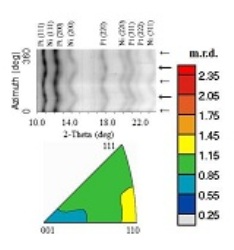Dec 14 2012
When materials are stressed, they eventually change shape. Initially these changes are elastic, and reverse when the stress is relieved. When the material's strength is exceeded, the changes become permanent. This could result in the material breaking or shattering, but it could also re-shape the material, such as a hammer denting a piece of metal. Understanding this last group of changes is the focus of research from a team including Carnegie's Ho-kwang "Dave" Mao.

Their breakthrough research on the behavior nickel nanocrystals under intense pressure is published December 14 by Science. Their findings could help physicists and engineers create stronger, longer-lasting materials. It can also help earth scientists understand tectonic events and seismicity.
It is believed that permanent changes to metallic grains when under pressure are associated with the movement of structural irregularities in the grains, called dislocations. But the deformation of nanocrystalline materials has been controversial because it was thought that below a certain grain size, the structural irregularities would not form and the deformation would be dictated by motions of the boundary between grains instead. According to computer analysis, this critical limit would occur in nanocrystals at sizes between 10 and 30 nm in size.
Experimental work on nanocrystals under pressure has been limited by technical hurdles. But new capabilities using a technique called radial diamond anvil cell x-ray diffraction has opened the door to moving beyond computer modeling and into the lab.
The team, led by Bin Chen of the Lawrence Berkeley National Laboratory, was able to show that the activities of the structural irregularities that accompany deformation were occurring even in nickel nanocrystals of 3 nanometers in size when they were compressed to higher than 183,000 times normal atmospheric pressure (18.5 gigapascals). This demonstrates that so-called dislocation-associated deformation is a function of both pressure and particle size, as previously thought, but that the particle size can be smaller than computer modeling had anticipated.
"These findings help constrain the fundamental physics of deformation under pressure on a very small scale," Mao said. "They also demonstrate the importance of the radial diamond anvil cell x-ray diffraction tool for helping us understand these processes."